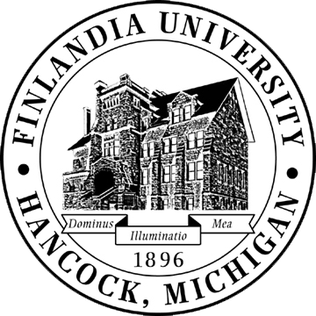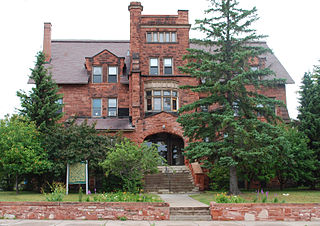
Hancock is a city in Houghton County in the U.S. state of Michigan. It is located across the Keweenaw Waterway from the city of Houghton on the Keweenaw Peninsula. The population was 4,634 at the 2010 census. The city has been consistently ranked as the third-snowiest city in the United States by The Weather Channel.

Torch Lake Township is a civil township of Houghton County in the U.S. state of Michigan. As of the 2010 census, the population of the township was 1,880. The township was established in 1886 and is one of the largest townships in Houghton County by area. It is surrounded by the Torch Lake, the Portage Lake, and Lake Superior. As well as a large number of unincorporated communities, the township also includes a portion of the Baraga State Forest which lies along the shores of Keweenaw Bay. The township borders Schoolcraft Township to the north, Osceola Township to the northwest, and Chassell Township to the southwest. The community of Hubbell serves as the major population center of the township, as well as hosting the Township Hall itself. The mostly uninhabited 91-acre Rabbit Island, located offshore in Lake Superior, is a part of the township.

Finlandia University is a private Lutheran university in Hancock, Michigan. It is the only private university in the Upper Peninsula. Founded in 1896 as The Suomi College and Theological Seminary, it is affiliated with the Evangelical Lutheran Church in America.

Gloria Dei Church, known locally as Old Swedes', is a historic church located in the Southwark neighborhood of Philadelphia, Pennsylvania, at 929 South Water Street, bounded by Christian Street on the north, South Christopher Columbus Boulevard on the east, and Washington Avenue on the south. It was built between 1698 and 1700, making it the oldest church in Pennsylvania and second oldest Swedish church in the United States after Holy Trinity Church in Wilmington, Delaware.

Trinity Evangelical Lutheran Church is a Victorian Gothic-style Lutheran church built in Milwaukee, Wisconsin in 1878 - then claimed to be "the finest church edifice within the Missouri Synod." Today it is listed on the National Register of Historic Places and is a designated State Historic Site. The building was also declared a Milwaukee Landmark in 1967, and today is the oldest church associated with the Lutheran Church–Missouri Synod in the city.

This is a list of the National Register of Historic Places listings in Houghton County, Michigan.

Augustus Lutheran Church is a historic church and Lutheran congregation at 717 West Main Street in Trappe, Pennsylvania. Consecrated in 1745, it is the oldest Lutheran church building in the United States. It continues to be used by the founding congregation for services during the summer. It was designated a National Historic Landmark in 1967.

The Gloria Dei Evangelical Lutheran Church is an historic church at 15 Hayes Street in Providence, Rhode Island. The single-story brick structure was designed by Martin Hedmark, and built in 1925-28 for a predominantly Scandinavian congregation established in 1890. The brick is laid in patterns, and the tower features a stepped gable roof. The corners of the main facade have small turrets, one topped with a lantern spire, the other with a needle. The design includes vernacular elements of Swedish architecture, a feature not generally found in the area. Originally, the church was built for a Swedish congregation, but today accepts many other nationalities and cultures, including Angola, Liberia, Tanzania, Portugal, Germany, Haiti, Jamaica, Britain, Bolivia, Dominican Republic, Guatemala, Mexico, and numerous others.

The Prayer Temple of Love Cathedral is located at 12375 Woodward Avenue in Highland Park, Michigan. It was built in 1929 as the Grace Evangelical Lutheran Church, and was listed on the National Register of Historic Places in 1982.

The Historic Trinity Lutheran Church is a church located in downtown Detroit, Michigan. It occupies the Trinity Evangelical Lutheran Church complex, located at 1345 Gratiot Avenue. It was designated a Michigan State Historic Site in 1981 and listed on the National Register of Historic Places in 1983. Its current pastor is Rev. Darryl L. Andrzejewski.

The Gethsemane Evangelical Lutheran Church is a church located at 4461 Twenty-Eighth Street in Detroit, Michigan. It was designated a Michigan State Historic Site in 1980 and listed on the National Register of Historic Places in 1982. The building now houses the Motor City Missionary Baptist Church.

Old Main, Suomi College is an educational building located on Quincy Street on the Finlandia University campus in Hancock, Michigan. It is also known as the Suomi College Building. It was designated a Michigan State Historic Site in 1959 and listed on the National Register of Historic Places in 1972.

Old East Paint Creek Lutheran Church is located north of Waterville, Iowa, United States. The church building was listed on the National Register of Historic Places in 1983.

Saint John's Lutheran Church is an active church building located at 121 South Locust Street in the city of Adrian in Lenawee County, Michigan. It was designated as a Michigan State Historic State on February 23, 1981 and shortly after listed on the National Register of Historic Places on December 27, 1984. The Lutheran congregation moved to a new home in 2007, and the church building now houses the Reformed Baptist Church of Lenawee.

Zion Evangelical Lutheran Church is a historic church located at 810 Petoskey Street in Petoskey, Michigan. It added to the National Register of Historic Places in 1986.

German Evangelical Reformed Church, also known as the Zoar Church, is a historic church located north of Newton, Iowa, United States. The congregation was established in 1876 by German immigrants, many of whom settled here in the late 1860s after first living in Freeport, Illinois. They built a small frame church on this property soon after, and the first burial in the cemetery behind the church building occurred in 1877. The present frame church was built by members of the congregation in 1892. It features a bell tower in the northeast corner, a gable roof, and a rock-faced stone foundation. Both the gablets on the tower and the front gable feature scalloped shingling. The entryway on the west side of the church was added in 1961. The house to the east of the church was the parsonage, which was sold in 1957. The church and cemetery were listed on the National Register of Historic Places in 1979.

Sheldahl First Norwegian Evangelical Lutheran Church is a historic building located in Sheldahl, Iowa, United States. The community was platted by Osmund Sheldahl and J.S. Polk. Sheldahl was a lay Lutheran minister who settled in Illinois in 1845. He and three others came to this area in 1854 in search of cheap available land. The following year, 21 families that had organized themselves as the "Palestine Congregation" relocated to Story County. Sheldahl became a large land owner and the regular pastor for Palestine Lutheran Church in 1860. He built a house in town in 1877 and he and his two sons built this church building in 1883. Osmund Sheldahl served the congregation as an unpaid pastor for 13 years. His will stipulated that the church building be made available to any Christian denomination that emphasized Bible teaching. It remained in regular use until 1936.

New Sweden Chapel is a historic Lutheran Church building located east of Fairfield, Iowa, United States in rural Jefferson County. The Swedish immigrant community that settled here was organized in 1845 under the leadership of Peter Cassel, a native of Kisa, Östergötland, Sweden. This was the first Swedish settlement in Iowa, as well as the first west of the Mississippi River. They established a Lutheran congregation in 1848, and built a log church in 1851. This church replaced it in 1860. Local builder Henri Jagle was responsible for building the 50-by-30-foot frame structure. It is four bays in length and features a 16-foot (4.9 m) tower with a spire over the main entrance. The interior features a painting by Olaf Grafström, who was an art instructor at Augustana College in Rock Island, Illinois. In 1948 the Augustana Evangelical Lutheran Church named the New Sweden Chapel as a National Synodial Shrine in recognition of its being the oldest congregation in the synod. Prince Bertil of Sweden and the Archbishop of Uppsala participated in a ceremony that drew 3,000 people. The chapel no longer houses a regular congregation, but is used for special occasions. A cemetery is located on the church grounds. The chapel was listed on the National Register of Historic Places in 1977.

Mount Pisgah Lutheran Church, also known in its early years as the First Lutheran Church and First English Lutheran Church and more recently as The Sanctuary on Penn, is located at 701 North Pennsylvania Street in downtown Indianapolis, Indiana. The historic church was built by the city's first Lutheran congregation, which organized in 1837, and was its third house of worship. The former church, whose present-day name is The Sanctuary on Penn, is operated as a for-profit event venue.

St. John's Lutheran Church, also known as Evangelical St. John's German Lutheran Church, was a complex of historic buildings located north of Kalona, Iowa, United States. This Lutheran congregation was organized in 1870 by German immigrants who settled in southern Johnson County in the 1860s. It began as a mission under the direction of the Rev. J. Hoerlin, Sr., and it was formally incorporated in 1875. The simple frame church building was completed that same year. It rested on a concrete block foundation, from 1917, and featured three round-arch windows on the side walls and a fanlight over the main entrance. When the Rev. H. Hertle came as the first resident pastor in 1878 a two-story frame parsonage was built next to the church. Behind the church and parsonage sat an outhouse and a catechetical room that was used for children's religious instruction. Services in English were begun in 1905 because the younger members no longer spoke German.























